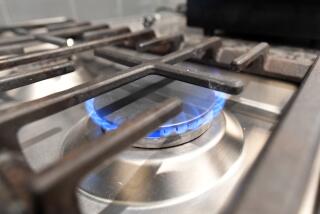How to Test Home for Carbon Monoxide Gas
- Share via
QUESTION: I heard that inadequate combustion air for a water heater and furnace is common and can cause carbon monoxide(CO) poisoning. How can I make sure I don’t have this problem and how can I test my home for CO gas?
ANSWER: With today’s more airtight energy efficient houses, a lack of adequate combustion air can easily occur. When this happens, deadly carbon monoxide (CO) gas can be produced. This also causes an inadequate flue draft, so the CO gas backdrafts inside your house, often while you sleep.
Carbon monoxide gas is a silent killer--odorless, colorless and tasteless. The early symptoms from mild exposure are very similar to the flu--headache, tiredness, nausea, etc. During one year, more than 20% of the patients with flu-like symptoms visiting a hospital emergency room actually had unacceptably-high levels of CO gas in their blood.
You can easily test your house to determine if there is adequate combustion air for your furnace and water heater and if CO gas is being produced. There also are other causes of CO gas production like a clogged or leaky flue, dirty or improperly adjusted burner, etc.
First, turn on all the exhaust fans inside your home and build a fire in your fireplace if you use it. Turn up the furnace thermostat to make sure it comes on. Open a hot water faucet so the water heater burner kicks on.
Hold a stick of incense under the draft hood on the flue immediately above the water heater tank. If you have adequate combustion air available, the smoke will be drawn into the draft hood.
If the smoke isn’t drawn in, you will have to increase the supply of combustion air. There are many simple methods to duct outdoor air to the furnace and water heater without wasting energy and creating chilly drafts. It can be as simple as running a small duct with an “air trap” at the end.
You should continually or at least regularly test your house for CO gas. There are battery-operated CO gas safety monitors that signal you if CO gas is detected. They make a sound similar to a smoke alarm and will awaken you from your sleep. Many CO gas deaths occur at night.
You can also use very inexpensive CO gas testing tablets. These tablets change color when a dangerous level is reached. Some new testing tablets are formulated to simulate the effect of CO gas on your body to more precisely sense the level. Place tablets in several locations and make a point to check them periodically especially during the heating season.
You can write to me at the address below for Utility Bill Update No. 139 listing the manufacturers of battery-operated CO gas monitors and new types of testing tablets, and do-it-yourself instructions and diagrams of how to bring in additional combustion air energy efficiently. Please include $1.50 and a self-addressed business-size envelope.
Insulation Needed Between Ceiling, Roof
Q: I am remodeling an older home with concrete walls and roof. There is a 16-inch gap between the top of the plastered ceiling and the roof. What is the best way to insulate the roof?
A: The roof must be insulated to reduce heat loss. You must also block warm, moist air from reaching the cold underside of the concrete roof. There it may condense and drip down on the ceiling below.
You will probably have to hire a contractor to cut holes in the ceiling and spray urethane insulation up on the underside of the roof. Another option is to add insulation over the top of the roof as in a commercial building.


